Economic Equality Caucus
which advocates for economic equality across the USA.
| Home | Organizational Structure | State Coordinators | Executive Director | Caucus Articles | Memberships | |||||
| "Delta Vision, Delta Voices" | ||||||||||
|
Help Advocate for Economic Progress and Equality. Donate to the Delta Caucus/Economic Equality Caucus. |
||||||||||
Delta Grassroots Caucus Events

Credit Michael Hibblen/ KUAR News, Arkansas Public Radio; Former President Bill Clinton speaking to the Delta Grassroots Caucus on May 2, 2013, at the University of Arkansas Clinton School of Public Service, Little Rock
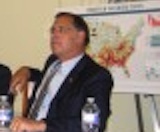
U. S. Senator John Boozman, Arkansas, at a Delta Grassroots Caucus meeting at the US Capitol
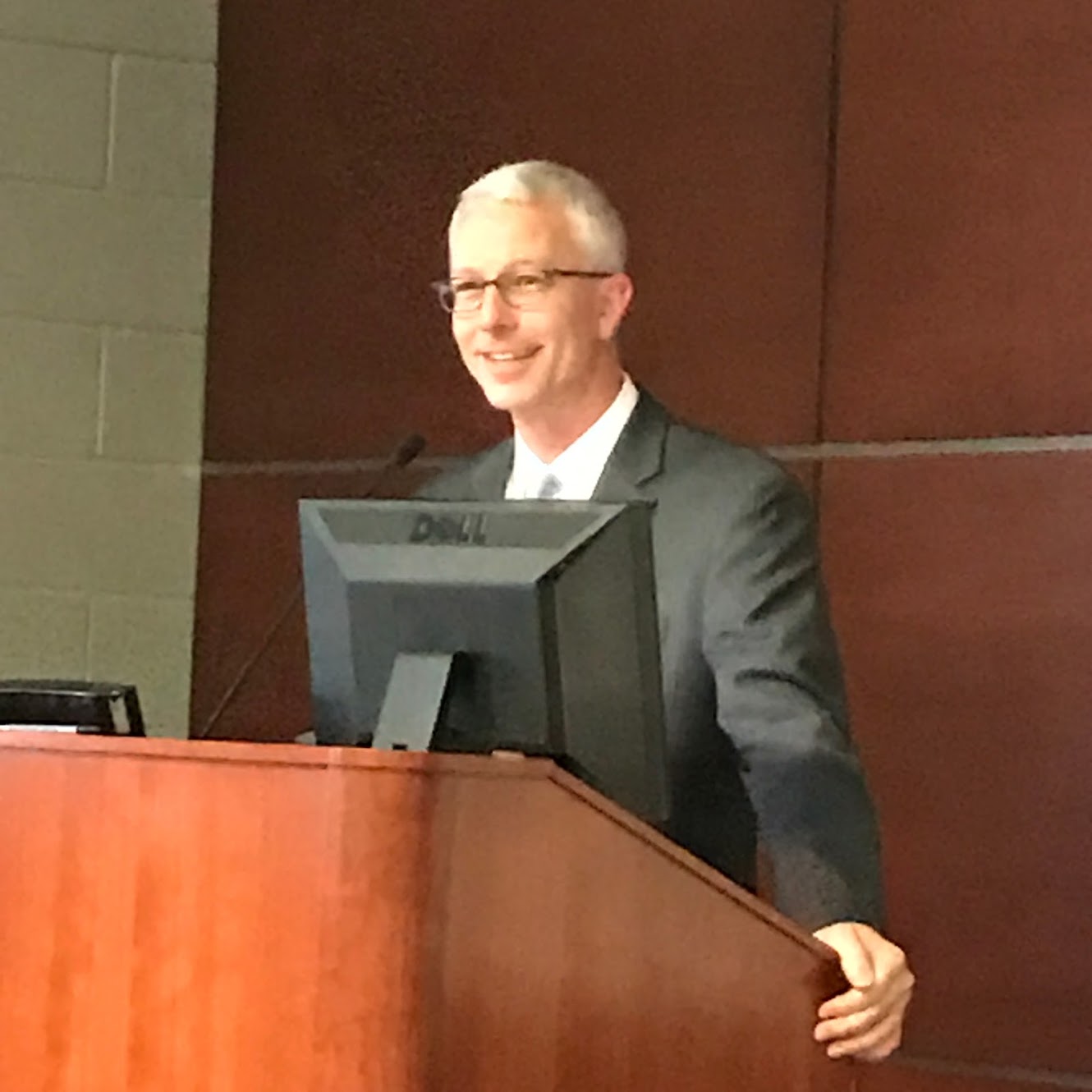
Brad Cole, Executive Director of the Municipal League of Illinois; previously a senior aide to former Republican US Sen. Mark Kirk of Illinois, earlier Mayor of Carbondale, Illinois, veteran Delta regional advocate, speaking at the Delta regional conference in West Memphis, Arkansas on April 26, 2019.
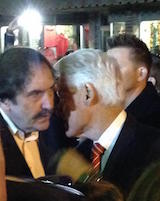
President Bill Clinton makes a comment to Delta Caucus Director Lee Powell at a meeting in Blytheville, Arkansas (in the northeast Arkansas Delta) on Nov. 2, 2014

The Delta Caucus would like to pay tribute to the late, great U.S. Sen. Thad Cochran of Mississippi, a powerful force in the US Senate for decades and a champion for the Delta. Sen. Cochran passed away on May 30, 2019. He spoke to the Delta Caucus on many occasions over the years (he is pictured above speaking to a Caucus event on Capitol Hill in Washington, DC) and his thoughtful, courteous and bipartisan leadership will be sorely missed.
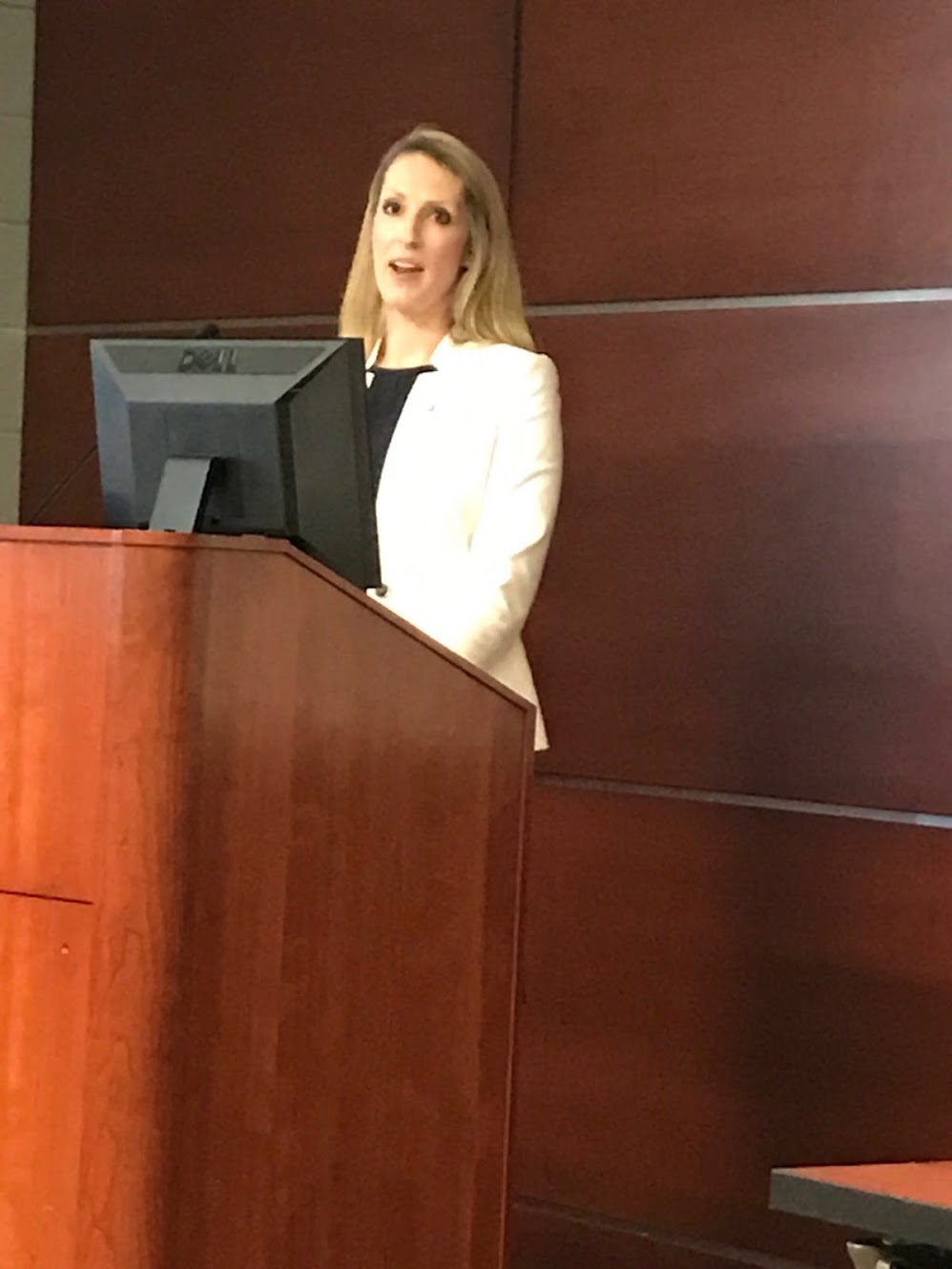
Marcie Lawson, Executive Director, Sikeston, Missouri Regional Chamber and Area Economic Development Corporation, speaking at the Delta regional conference in West Memphis, Arkansas on April 26, 2019.
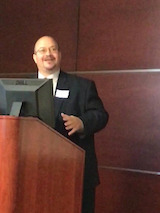
Alan Gumbel, Greater Memphis Alliance for a Competitive Workforce, Memphis, Tennessee, speaking at the Delta regional conference in West Memphis, Arkansas on April 26, 2019.
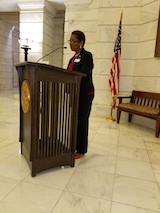
Mayor Shirley Washington of Pine Bluff, AR, speaking to the Delta Caucus at the Arkansas Capitol Rotunda in 2017.
“Delta Vision, Delta Voices”
<< Previous | Table of Contents | Next >>
Foreword from Rodney E. Slater, Secretary of Transportation
Mr. President:
It has been my privilege to work with you on the Mississippi Delta Regional Initiative—an issue of vital importance to the social and economic policy agenda of the Clinton-Gore Administration. As a son of the Delta, perhaps no issue has more significance to me personally or more potential for human impact than this Administration’s ongoing initiative to address the social and economic challenges facing the Mississippi Delta region of the United States. This Report presents a dynamic series of goals and recommendations for the region’s future as we enter the new century and a new millennium. While gradual progress has been made in many areas across the Delta, we realize the compelling need to work together for a historically impoverished region that has bestowed a rich cultural heritage upon our nation and contributed mightily to its productivity, yet still lags behind in the realms of social and economic progress.
I know of the great work ethic and values of the Delta’s people, as well as the region’s poverty and limitless potential. I was born in Tutwiler, Mississippi in 1955, and grew up in Marianna, Arkansas, one of America’s poorest areas. At age six I held my first job working in a cotton field with my mother to earn the money for my first means of transportation—a bicycle. I learned the value of hard work growing up in Lee County, Arkansas, and I will never forget those lessons learned among the creative, energetic people of my home in the Mississippi Delta.
The unique attributes and needs, as well as the human and natural resources of the Delta have much to contribute to the economic and social fabric of the country. It is a “new market” for goods and services produced around the world and in the communities within its boundaries. It is a treasure of American history, culture and natural beauty. Its unique voice has been central to the growth of our own country and to the expansion of America’s conscience and impact around the globe.
Therefore, I am honored to present this Report to you—Delta Vision, Delta Voices: The Mississippi Delta Beyond 2000. It is the product of the inter-agency task force that you established, and which I have been privileged to lead, to present dynamic goals and recommendations for the future of the Mississippi Delta. We know that the Federal government is only one actor in the region’s development. Thus, a major part of this Report—entitled “Voices of the Delta”—consists of goals and recommendations written by a broad spectrum of grassroots organizations, including nonprofit foundations, elected officials, business, community and religious leaders, educators, as well as groups focused on transportation, agriculture, tourism, and many other vital issues. I want to commend both the “Voices of the Delta” as well as the Federal departments and agencies that comprised the task force and contributed so fully to its work.
These recommendations reflect the spirit of fiscal responsibility and strategic investment that you and the Vice President worked so tirelessly to usher in during the decade of the 1990s, leading to a new era of government fiscal responsibility, budget surpluses and record investment in these areas that strengthen America and Americans for the untold challenges and limitless opportunities of the new century and the new millennium. The recommendations focus on making sound investments for initiatives that work to promote sustainable, long-term development. As you stated in your 2000 State of the Union Address—the first of the new millennium—we must always be aware of the need to avoid channeling our energies into policies that have proven ineffective, but instead to invest our resources in “what works” for long-term progress. The people of the Delta, of course, listened with great interest to your proposals for assistance to the Delta. Through your fiscal year 2001 budget proposal, as well as your support for the Delta Regional Authority, you demonstrated your resolve to institutionalize proven strategies to direct more resources to the distressed areas of the region. This Report embodies a wealth of experience and practical knowledge—primarily gleaned from people who live and work in the region—about “what works” for the Delta.
The Report updates and expands the work you and others rendered when you served as Chair of the Lower Mississippi Delta Development Commission. This commission was formed in l988 by the bipartisan efforts of former United States Senator Dale Bumpers of Arkansas, former Congressmen Mike Espy of Mississippi (your first Secretary of Agriculture) and Bill Alexander of Arkansas, as well as prominent Republicans, including Senator Thad Cochran of Mississippi, the late Congressman Bill Emerson of Missouri, and former Congressman Webb Franklin of Mississippi. This Administration’s Delta initiative has sought to move forward in that same open spirit.
The original Commission placed an emphasis upon listening to the voices of the people throughout the region, conducting research and holding hearings in the region to gather the ideas and advice of the Delta. We have followed that example. In 1990 you submitted the Commission’s Report, The Delta Initiatives: Realizing the Dream…Fulfilling the Potential, to President George Bush, calling for an aggressive plan of revitalization and development of the Delta. In keeping with its Congressional mandate, the Commission focused on developing a ten-year economic plan for the Delta and assembled an ambitious public and private sector agenda for recommended implementation. While the original legislation ended the work of the Commission after submitting its Report to the President in 1990, the commitment to the implementation of the goals and recommendations has continued to this day.
During the Clinton-Gore Administration, we have continued the work and the dialogue with the region’s people initiated in 1988-90. For example, many of the transportation and community development recommendations in The Delta Initiatives had already been achieved by 1995. While I served as Administrator of the Federal Highway Administration, we published the Report Linking the Delta Region with the Nation and the World, an update of transportation and employment-related issues in the Delta. That document related the emergence of community development innovations such as the new Empowerment Zone/Enterprise Community (EZ/EC) program designed to promote economic development and improve the quality of life in distressed areas. Under Vice President Gore’s leadership and that of former Mississippi Congressman and Agriculture Secretary Mike Espy, the Administration began working on this program from its first year in office in 1993, and approximately one-fourth of all the rural EZ/ECs nationwide that were announced in 1994 were located in the Delta. The program’s success led to its expansion to a second round in 1999, and proposes a third round in the FY2001 Budget.
The 1995 Federal Highway Administration Report analyzed the progress toward fulfilling most of the Commission’s transportation recommendations. That progress has continued throughout the decade. The Delta has directly benefited from dramatic increases in the Highway Trust Fund receipts brought about by the Intermodal Surface Transportation Sufficiency Act of 1991 (ISTEA) and the Transportation Equity Act for the 21st Century (TEA-21). The major challenges that remain are now being tackled—as demonstrated by your FY 2001 budget proposal—with support for Interstate 69 and the Great River Bridge among the prominent examples. This Report will recommend new actions for finishing the quest to build an integrated Delta transportation network for the 21st century, ensuring that the New Markets of the Delta are accessible into the new millennium.
This Report also marks another step toward fulfilling the Mississippi Delta Regional Initiative Memorandum of Understanding (MOU) signed in July l998 at a meeting of Federal officials and Delta grassroots leaders in Memphis, Tennessee convened at LeMoyne Owens College. At the Memphis conference, nine Federal agencies joined the Department of Transportation, including Agriculture, Labor, Interior, Education, Health and Human Services, Commerce, Housing and Urban Development, the Small Business Administration and the Environmental Protection Agency, to sign the MOU to establish a framework for promoting economic revitalization in the region. The Memorandum also underscored the rural nature of much of the Delta, stating: “This effort will build upon the work of President Clinton and Vice President Gore to strengthen rural communities for the 21st century.”
The departments and agencies stressed the importance of cooperating with State and local organizations in developing plans for revitalizing the region. The MOU was expanded further in 1999 with the addition of other Federal Departments and Agencies—the Departments of Treasury, Defense, Justice, Energy and Veterans’ Affairs, the Office of Personnel Management, the Social Security Administration, and the National Office of Drug Control Policy.
I would like to extend my deep appreciation to all the people in the federal agencies who have worked so hard on this Initiative. In particular, I would like to thank the Department of Transportation employees who worked so hard in providing coordination as the lead agency for this Initiative. The DOT Chief of Staff, Jerry Malone, is a native of Earle, Arkansas who has spoken at listening sessions and other major events in the Delta, and provided overall leadership for the personnel working on the project. A core team of four DOT employees worked steadfastly day by day from the inception of the initiative: Al Eisenberg, Deputy Assistant Secretary for Policy; Linda Darr, Deputy Assistant Secretary for Budget; Harold Gist, Associate Director for Intergovernmental Affairs; and Lee Powell, who is based in the USDA EZ/EC program but devoted almost an entire year on a full-time detail to the Delta Initiative. Many other DOT employees devoted countless hours to the initiative, as did many employees in the other agencies involved—we commend all of them for their attention to the issues regarding a vital region in America’s heartland.
One focus of the Delta 2000 Initiative has been gathering data and consulting with the Delta’s people to gain an honest insight into where we are now and what needs to be done in promoting the region’s development. This Report will provide brief highlights of Federal activities in the region during the 1990s. People wishing to know more about these activities are invited to consult the September 1999 Mississippi Delta: Beyond 2000 Interim Report and the exhaustive “Inventory of Federal Activities in the Delta Region,” both published at the Department of Transportation’s new Delta Website at http://www.dot.gov/delta. The Interim Report and “Inventory”—a Clinton-Gore Administration-wide, inter-agency effort cataloguing the Federal efforts and presence in the Delta region—demonstrated that in many areas, progress has been achieved toward fulfilling many of the recommendations in The Delta Initiatives of 1990, but that much still remains to be done.
Many areas in the region demonstrated gradual progress in recent years. From 1993 to December 1999, the unemployment rate for the 219-county region declined from 7.5 percent to 4.2 percent. However, many rural counties still lag far behind the national average—which remained in the range of 4.1 percent at the end of the decade—as well as the regional average, in employment and per capita income. Urban counties in the Delta had an unemployment rate of only 3.1 percent, while the rural counties had a higher rate of 4.9 percent. This assessment of where we stand today was taken in the spirit of your statement in the 1990 Report that the Delta cannot become a full partner in America’s future without “an honest assessment of where we are in the emerging global economy and what we have to do to increase the capacity of all our people to succeed in it.”
The Federal government is only one actor in the Delta. An entire section of this Report is devoted to the proposed solutions and goals presented by people who live and work in the Delta, including several grassroots organizations; nonprofit foundations; transportation groups like the Interstate 69 Initiative; the Delta Race Relations Consortium, interfaith organizations, labor and other groups and individuals focusing on diversity issues; private business and industry leaders; 600 participants in a series of listening sessions conducted in the fall of 1999; representatives of your 21st Century Commission on American Agriculture who live in the region; as well as other voices. Their concepts, in tandem with the recommendations submitted by the Federal departments and agencies, all contribute to this Report and share a commitment toward advancing the social and economic progress of the Delta and that of our American family who call this region home.
This Report analyzes an immense number of issues and problems. Considering the myriad specific issues examined in detail, I would like to highlight a few recurring, fundamental themes:
A permanent regional planning and development entity: Through our extensive consultations with the people of the Delta as well as with Federal officials, we found strong support for a regional planning and development organization. As the 1990 Report advocated, such a commission or authority would monitor progress in the region, ensure implementation of the Commission’s recommendations, avoid duplication, provide for cooperative participation by Federal, State, local, private sector, and other grassroots organizations, and address funding issues.
Regional technical assistance and fair access to funding: One of the great challenges of the poorest and smallest communities in the Delta flows from their lack of staff and other resources to become informed about and make appropriate applications for all the Federal, State, nonprofit foundation funding opportunities available to them. Through the use of circuit riders to provide technical assistance and other outreach activities, the Delta Initiative supports a major expansion of efforts to enable these disadvantaged communities to gain equitable access to these resources.
An increase in resources devoted to the region: The goals and recommendations are fiscally responsible, as we maintain the budget discipline that you and the Vice President have championed and that has enabled the Federal government to move from soaring deficits in 1993 to an unprecedented surplus by 1999. Any proposed increases in funding have followed two basic principles. First, they respected the fiscal discipline that has helped make the nation’s economic prosperity possible. Secondly, they pursued policies that have been demonstrated to be sound investments that create jobs, promote economic development and improve the quality of life in the new markets of the Delta region. The Delta 2000 Initiative does propose an increase in Federal funding for the region from fiscal years 2001 to 2005. Given the persistent poverty and economic distress still present in many Delta areas, such an investment in its people is not only appropriate but also needed and richly deserved.
The Delta today still faces many challenges—from empowering the economies of the most depressed rural areas and inner city neighborhoods, to enhancing health care and housing for all residents, regardless of racial, ethnic and economic status, to advancing beyond the gradual progress made during the 1990s in such areas as education, transportation, conservation of natural resources, and community development. It has many strengths on which to build. These strengths are its history, its families, its natural resources, its culture—all cultivated through community institutions such as churches, schools, and universities, including its Historically Black Colleges and Universities. We have benefited profoundly by listening carefully to the ideas and counsel of our partners at the State and local levels, the private sector, nonprofit foundations, and grassroots organizations of the region. In that spirit of partnership, the recommendations and goals presented herein build upon the “handbook for action” that you inspired as Chair of the Commission in 1990. We call upon all people devoted to the progress of the region lying at America’s heart to join us, as we expand upon the work of revitalization begun in 1990 and bring it forward into the new century and the new millennium.
Respectfully,
Secretary Rodney E. Slater, United States Department of Transportation
Back to the top